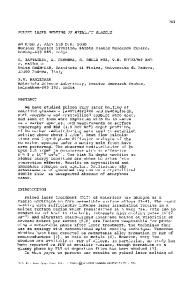Pulsed Laser Melting of Amorphous Silicon: Time-Resolved and Post-Irradiation Studies
- PDF / 1,054,777 Bytes
- 6 Pages / 417.6 x 639 pts Page_size
- 90 Downloads / 319 Views
PULSED LASER MELTING OF AMORPHOUS SILICON: POST-IRRADIATION STUDIES
TIME-RESOLVED AND
D. H. LOWNDES, R. F. WOOD, C. W. WHITE, AND J. NARAYAN Solid State Division, Oak Ridge National Laboratory, P.O. Box X, Oak Ridge, TN 37831 USA
ABSTRACT
Measurements of the time of the onset of melting of self-implantation amorphized (a) Si, during an incident laser pulse, have been combined with modified melting model calculations and measurements of surface melt duration to demonstrate that the thermal conductivity, Ka, of a-Si is very low (-0.02 W/cm-K). Ka is also shown to be the dominant parameter determining the dynamical response of ionimplanted Si to pulsed laser radiation; the latent heat and melting temperature of a-Si are relatively unimportant. Cross-sectional transmission electron micrographs on implantation-amorphized Si layers of several different thicknesses show that for energy densities less than the threshold value for complete annealing there are usually two distinct regions in the re-solidified a-Si, consisting of fine-grained and large-grained polycrystalline Si, respectively. The presence of the fine-grained poly-Si suggests that bulk nucleation occurs directly from the highly undercooled liquid phase. Thermal melting model calculations suggest that the nucleation temperature, TnF is -1200 0 C.
INTRODUCTION In this paper we summarize the results of recent time-resolved reflectivity measurements [1,2] and model calculations [1,3] which, together with post-irradiation TEM studies [2-4], have allowed us to study the transformation of amorphous (a) silicon to the highly undercooled liquid (1) phase and the subsequent solidification process. The time-resolved measurements employ a new technique [1,2] that allows us to determine the time, tm, of the onset of melting of ion-implanted a-Si during an incident laser pulse, as well as conventional measurements of the duration, Ts, of the high reflectivity phase (HRP) associated with surface melting, both as functions of the laser energy density, EZ. One of the principal results of the work reported here is a demonstration of the dominant role played by the low thermal conductivity, Ka of a-Si, relative to the crystalline (c) value, in determining both the melting threshold value of EZ and the subsequent solidification behavior of partially molten layers of a-Si, at higher EZ. The tm measurements provide a particularly powerful constraint in fixing the value of Ka- We conclude that the dynamics of pulsed laser melting and resolidification are relatively insensitive to the values of the melting temperature, Ta, and the latent heat of fusion, La, of a-Si. This result seems significant in view of the conflicting conclusions regarding Ta obtained by several groups [5--11]. We also note that our approach is complementary to recent measurements by Olson et al. [5,6] and by Donovan et al. [7], both of whom used continuous heating of a-Si in the solid phase for the estimation of properties such as Ta and La. Since a-Si apparently does melt at Ta Ta) ~1200°C [2,3]. OMNL-DWG
Data Loading...

